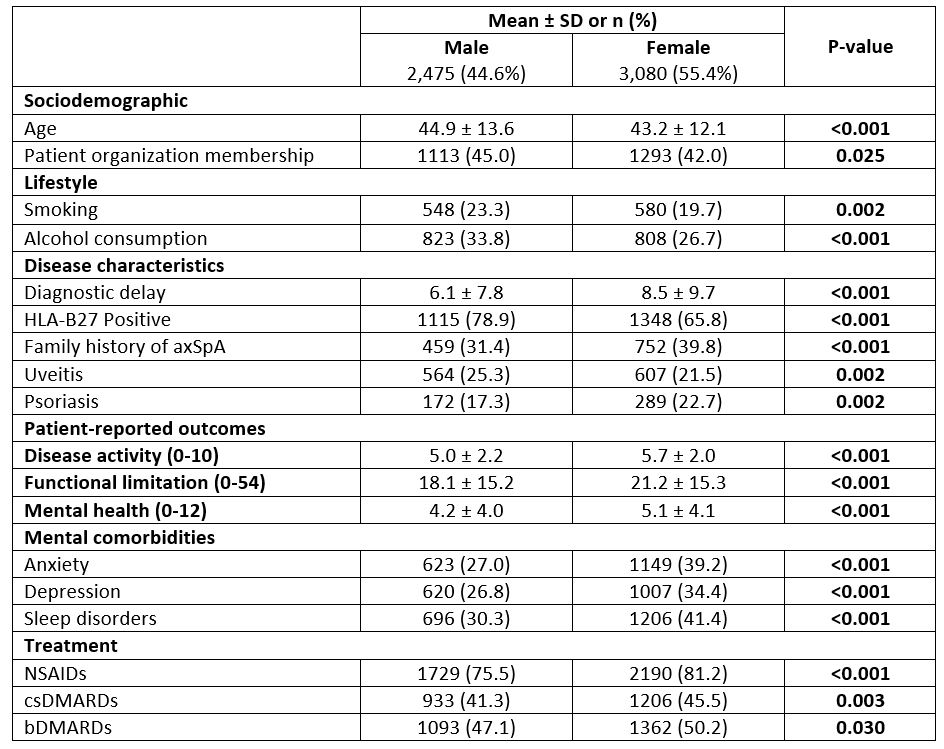Session Information
Session Type: Poster Session C
Session Time: 9:00AM-11:00AM
Background/Purpose: There is increasing evidence of differences between males and females in axial spondyloarthritis (axSpA), but the source is restricted to specific geographic locations or populations. This analysis aims to assess gender differences in a large sample of patients included in the International Map of Axial Spondyloarthritis (IMAS) study from around the globe.
Methods: IMAS is a cross-sectional online survey (2017-2022) of 5,557 unselected axSpA patients from 27 countries. The current analysis looked at the differences in a variety of patient and disease characteristics/assessments between males and females. The factors evaluated were: sociodemographic (age, educational level, marital status, employment status, and patient organization membership), health behaviours (smoking, alcohol consumption, and physical activity), disease characteristics (age at symptom onset, diagnostic delay, HLA-B27, family history of axSpA, uveitis, inflammatory bowel disease), patient-reported outcomes (disease activity [0-10] on the BASDAI scale, spinal stiffness [3-12], functional limitation [0-54], and mental health [0-12] using GHQ-12 scale), mental comorbidities (anxiety, depression, and sleep disorders), and treatments (NSAIDs, csDMARDs and bDMARDs).
Results: Data from 5,555 patients reporting gender were analyzed: 3,492 from Europe, 769 from North America, 600 from Asia, 548 from Latin America, and 146 from Africa. Globally, 55.4% were females, with higher proportions in South Africa (82.2%) and lower in Asia (20.8%; Figure 1). Compared to males, females were of a younger age, more frequently university educated, more often divorced, more commonly on permanent sick leave, and less often members of patient organizations. With respect to health behaviours, male participants smoked and drank more than females.Compared to males, diagnostic delay was significantly longer (by 2.4 years) while the rate of HLA-B27 positivity and family history with axSpA were lower in females. With respect to patient-reported outcomes, females presented with higher disease activity, greater functional limitation, and poorer mental health. The use of axSpA drug treatment was more common in females with a higher proportion having ever taken NSAIDs, csDMARDs and bDMARDS (Table 1).
Conclusion: Globally, females with axSpA practiced better health behaviors and reported lower frequency of HLA-B27 positivity but had longer diagnostic delay. Despite more frequently receiving medication, females presented with higher disease activity, greater functional limitation, and worse mental health. Reducing the disease burden and diagnostic delay in females is crucial to improving axSpA care around the world.
To cite this abstract in AMA style:
Navarro-Compán V, Garrido-Cumbrera M, Poddubnyy D, Bundy C, Makri S, Correa Fernandez J, Murlidhar Akerkar S, Wermskog L, Karam E, Siddiqui A, Sommerfleck F. Females with Axial Spondyloarthritis Report Higher Burden of Disease and Worse Patient-reported Outcomes. Results from the International Map of Axial Spondyloarthritis (IMAS) [abstract]. Arthritis Rheumatol. 2023; 75 (suppl 9). https://acrabstracts.org/abstract/females-with-axial-spondyloarthritis-report-higher-burden-of-disease-and-worse-patient-reported-outcomes-results-from-the-international-map-of-axial-spondyloarthritis-imas/. Accessed .« Back to ACR Convergence 2023
ACR Meeting Abstracts - https://acrabstracts.org/abstract/females-with-axial-spondyloarthritis-report-higher-burden-of-disease-and-worse-patient-reported-outcomes-results-from-the-international-map-of-axial-spondyloarthritis-imas/


